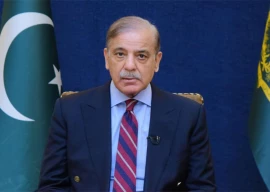
Despite unfavourable economic and political headwinds, it is commendable that the current government is aiming for a take-off in the form of initiative titled "Uraan Pakistan".
It is of utmost importance that the pilot and co-pilot understand and agree upon their respective roles through this Uraan and a proper cabin crew is chosen and assigned tasks and responsibilities in a clear manner. The choice of crew for "business" class would be the most important, including a briefing to them for adopting a friendly behaviour rather than intimidation.
In terms of announcement of the destination and route, there are a few elements that manifest the typical political sloganeering rather than a reflection of ground (air) realities and a practical and achievable route map. The first E of the five pillars titled 5 Es, ie, exports, could be particularly mentioned.
Before delving into the targets for exports, it is noteworthy to highlight some gaps and challenges at the macro level.
First and foremost, the targets of a $1 trillion economy by 2035 and a $3 trillion economy by 2047 seem overly ambitious, especially considering Pakistan's current economic growth trajectory and the global economic outlook. Achieving such growth requires consistent high performance across various sectors, which may be challenging given the existing structural and political constraints.
Second, the initiative lacks a detailed and practical roadmap, outlining specific policies, timelines, and resource allocation. Without a clear implementation plan and assigned responsibilities at institutional, provincial and decentralised levels, it risks becoming another grand vision document with limited practical impact.
Third, while focusing on exports and foreign investment, the initiative seemingly overlooks crucial internal challenges. Addressing issues like corruption, bureaucratic inefficiencies, energy shortages, and political instability is critical for creating a conducive environment for sustainable economic growth.
Even institutions like SIFC have not been able to overcome these challenges and pave the way for normal investors, who do not enjoy sovereign backing.
Fourth, the initiative primarily focuses on economic growth, with limited emphasis on social development indicators like poverty reduction, healthcare, and education. Sustainable economic growth requires a holistic approach that addresses social inequalities and improves human capital.
Fifth, the initiative appears to be top-down, with limited public engagement in its formulation. A broader consultation process involving various stakeholders, including the civil society, academia, and private sector, would enhance ownership and ensure inclusivity.
Coming back to exports, where the target is to double them, ie, $60 billion annually. Best of luck; that is all one could say given the current state of affairs of export-oriented sectors.
Achieving the export target heavily relies on favourable global economic conditions and access to international markets. Factors like global recessions, protectionist policies, and geopolitical tensions are not favourable and could significantly hinder this target for Pakistan's export growth. Cannot we learn from the recent five years?
Moreover, the operating capacity of current export-oriented sectors tells a very different story, with very limited margin for expansion, tough competition from global suppliers, and less operating margins due to downward shifts in global markets.
It is good to focus on agriculture, IT, creative sectors and the blue economy, but how much time and resources it would take to do so? Do we have sufficient exportable capacity in agriculture, given the increasing internal pressure on food security and the lack of water?
How much we have grown in the IT sector despite being given maximum incentives and focus, and presence in global markets for years? What are the creative industries identified for development and how much is the exportable surplus or capacity in these?
What we have done for development of the blue economy and how much time we would take to be able to harness the export potential? These are very basic questions that need economic assessment and a feasibility analysis before converting into political slogans.
To enhance the effectiveness of Uraan Pakistan, the following may be considered: Developing a detailed implementation roadmap with clearly outlined specific policies, timelines, and resource allocation for each sector. Prioritising institutional reforms through addressing corruption, bureaucratic hurdles, and improving governance to create a conducive business environment.
Investing in human capital by enhancing focus on education, healthcare, and skill development to increase productivity and social well-being. Promoting sustainable and inclusive growth by ensuring environmental sustainability and social inclusion in all economic activities.
Fostering public-private partnerships by encouraging collaboration between the government, private sector, and civil society for effective implementation.
Uraan Pakistan has the potential to be a game changer for Pakistan's economy, if implemented through the adoption of a more comprehensive and inclusive approach. However, its success hinges on designing and instituting a realistic implementation plan, with not only clearly defined targets but also the accountability mechanism to hold people responsible for failure to achieve such targets.
The writer is an international economist




1719211536-0/BeFunky-collage-(81)1719211536-0-165x106.webp)



















COMMENTS
Comments are moderated and generally will be posted if they are on-topic and not abusive.
For more information, please see our Comments FAQ